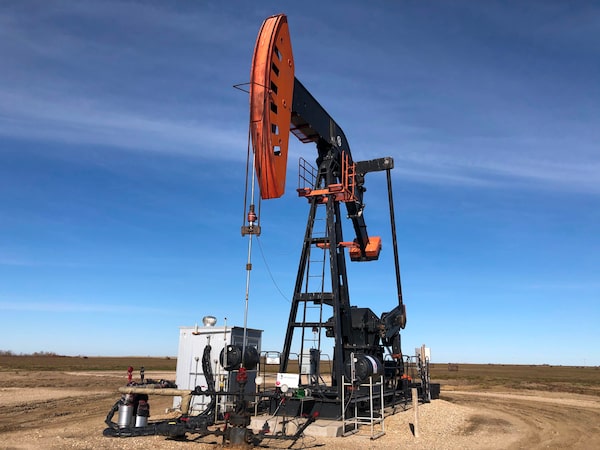
In this file photo taken on Oct. 20, 2019 an oil rig is seen in Stoughton, Sask.KATIE SCHUBAUER/AFP/Getty Images
The Government of Saskatchewan’s climate change strategy, Prairie Resilience has reduced the threshold requirements of carbon dioxide equivalent from upstream oil and gas production facilities, to allow smaller facilities to opt in to the provincial plan and opt out of the federal carbon tax.
The goal is to not just help reduce greenhouse gas (GHG) emissions but to also maintain a competitive economy in Saskatchewan.
In 2019, through the Prairie Resilience strategy, the provincial government introduced performance standards that are required for facilities that emit at least 25,000 tonnes of carbon dioxide equivalent in the province.
By signing on with the Prairie Resilience strategy, these facilities were exempt from federal carbon taxes.
However, owners of some facilities that did not meet the 25,000 tonnes of CO2e that wanted to opt into the strategy and facilities between 10,000 and 25,000 tonnes of emissions.
“Since the regulations and voluntary registration were introduced, 66 large emitting facilities and 24 aggregates containing more than 10,000 individual facilities are now registered in the program and must comply with provincial climate change legislation,” Environment Minister Dustin Duncan said.
“These facilities generate 13 per cent, or approximately 10.3 million tonnes, of total provincial emissions and are expected to reduce that portion by a total of 10 per cent by 2030. We also expect many new companies to register aggregate upstream oil and gas facilities as part of the most recent amendments.
The new amendments allow small producers to opt in to the system.
“We allowed for companies that have facilities that produce between 10,000 and 25,000 tonnes to voluntarily opt in to our system if they wanted to, and then there was no coverage for facilities that emit zero to 10,000 tonnes,” said Duncan.
Amendments were made to allow for voluntary registration for facilities in the upstream oil and gas sector wishing to combine emissions into an aggregate facility, for a combined 10,000 tonnes of CO2e.
In July 2020, government directed that the emissions threshold for voluntary registration be lowered from 10,000 tonnes CO2e to zero tonnes CO2e for upstream oil and gas aggregate facilities.
“Since the regulations and voluntary registration were introduced, 66 large emitting facilities and 24 aggregates containing more than 10,000 individual facilities are now registered in the program and must comply with provincial climate change legislation,” said Duncan.
“These facilities generate 13 per cent, or approximately 10.3 million tonnes, of total provincial emissions and are expected to reduce that portion by a total of 10 per cent by 2030. We also expect many new companies to register aggregate upstream oil and gas facilities as part of the most recent amendments.”
Registration in the program also protects those facilities from the federal carbon tax. Instead of paying the increasing federal price per tonne of GHGs, the companies must reduce the intensity of their emissions from 2019 onward, or comply through one of the three following provincial mechanisms:
Saskatchewan Technology Fund. Emitters may choose to pay into a new technology fund should they not reduce their emissions intensity as per the legislated schedule. The fund will be administered by Innovation Saskatchewan. Money from the fund will then be allocated to successful projects that drive innovation and reduce GHG emissions at regulated facilities, through a competitive and criteria-based application process.
Best performance credits will be generated by regulated facilities that reduce emissions beyond what is required in their performance standard. The design of the performance credit program will incentivize GHG emissions reductions for regulated emitters. The Ministry of Environment developed the necessary standards to implement a best performance credit system in fall 2020.
The Ministry of Environment held initial engagement on Saskatchewan’s offset program in 2019, but postponed further engagement due to the COVID-19 pandemic. The ministry is currently re-evaluating the means through which meaningful engagement may take place while ensuring the health and safety of staff and participants. Further engagement on offsets will continue over the next year. In the meantime, the ministry will continue to develop proposed offset protocol including agricultural soils sequestration, enhanced oil recovery, composting, landfill gas, and opportunities for regional and/or national alignment.
“The new threshold to the output-based performance standards will enable many smaller oil and gas producers to be covered by provincial regulation and protect them from the federal carbon tax, which will save them millions of dollars.
“Our provincial standards are designed to achieve real GHG emission reductions, while at the same time protecting competitiveness and limiting carbon leakage and investment flight to jurisdictions with lower regulatory standards,” said Energy and Resources Minister Bronwyn Eyre.